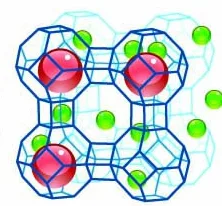A Nature Materials article published on line in June of this year charts an interesting approach to making very very small, very efficient silver phophors. The many authors, including Oliver Fenwick of CNRS and Eduardo Coutiño-Gonzalez of the University of Leuven, entitled their article “Tuning the energetics and tailoring the optical properties of silver clusters confined in zeolites,” which effectively obfuscates the work’s significant practical potential.

This article came to me because, improbable as it seems, I have done research on zeolites. (Kenneth I. Werner, Positronium Annihilation in Zeolites, Master’s Thesis, University of North Carolina, Chapel Hill, 1969) Since then, I have rarely come across zeolites except in one of their major commercial application as ion-exchange media for water softening and filtration systems. Other uses include laundry detergents (the largest use) and non-clumping cat litter. A benefit of these applications is that zeolites are made inexpensively and in large quantities.
But what exactly are zeolites? They are aluminosilicates that contain cavities connected by microchannels as part of their molecular structure. The cavities commonly contain positive ions such as sodium, potassium, and calcium. They are loosely bound in the pores, and can be easily replaced by other ions in a solution, so the zeolites are called ion-exchange media.
Zeolites, both natural and synthetic, have many different cavity-and-channel structures, and the dimensions of the cavities and channels vary from type to type. The cavities can be as small as a few angstroms, which means they function as quantum wells. (If you don’t remember your introductory quantum mechanics, don’t worry. I won’t bring it up again.)
Now for the silver part. Small clusters consisting of only a few silver atoms exhibit strong and highly efficient fluorescence, but in most environments the clusters aggregate and form large clusters that behave pretty much like bulk silver.
You know what’s coming next. Fenwick, Coutiño-Gonzalez, and colleagues inserted silver clusters into the cavities, where the small cavity size kept the micro-clusters stable. The authors found that the size and shape of the cavities had a powerful effect on fluorescence of the microclusters, with the photoluminescent quantum yield approaching one in the best cases.
In his 2015 Ph.D. dissertation, Coutiño-Gonzalez reported the fabrication of “a fluorescent lamp prototype, in collaboration with Philips R&D, using Ag-zeolite based phosphors. …At the end of the fabrication process a working lamp was obtained, however the lifetime and yield of the lamp did not fully meet the standards required for commercial lamps.”
Right. Don’t forget the engineering.
Ken Werner is Principal of Nutmeg Consultants, specializing in the display industry, manufacturing, technology, and applications, including mobile devices and television. He consults for attorneys, investment analysts, and companies re-positioning themselves within the display industry or using displays in their products. You can reach him at [email protected].

